Design of a Ka-Band Heterogeneous Integrated T/R Module of Phased Array Antenna
Abstract
1. Introduction
2. Related Works
3. Architecture Design
3.1. Architecture Scheme of 3D Heterogeneous Integration
3.2. Link Design of T/R Module
3.3. Device-Based Packaging Design
4. Optimization of Interconnection Structure
4.1. Design of Device Based Interconnection Interface
4.2. Design of RF Full-Path Interconnection
5. Testing the Key Parameters of the Device-Based T/R Module
6. Conclusions
Author Contributions
Funding
Data Availability Statement
Conflicts of Interest
References
- Han, G.; Du, B.; Wu, W.; Yang, B. A Novel Hybrid Phased Array Antenna for Satellite Communication on-the-Move in Ku-band. IEEE Trans. Antennas Propag. 2015, 63, 1375–1383. [Google Scholar] [CrossRef]
- Alakija, C.; Stapleton, S.P. A mobile base station phased array antenna. In Proceedings of the 1992 IEEE International Conference on Selected Topics in Wireless Communications, Vancouver, BC, Canada, 25–26 June 1992. [Google Scholar]
- Hu, R.; Li, X.; Deng, J.; Zhou, J.; Dong, S.; Liu, L.; MA, W. Research on the Architecture of Phased Array Antenna of LEO Communication Satellites Based on Hybrid Beamforming. Space-Integr.-Ground Inf. Netw. 2021, 2, 8. [Google Scholar]
- Hong, W.; Jiang, Z.H.; Yu, C.; Zhou, J.; Chen, P.; Yu, Z.; Zhang, H.; Yang, B.; Pang, X.; Jiang, M.; et al. Multibeam Antenna Technologies for 5G Wireless Communications. IEEE Trans. Antennas Propag. 2017, 65, 6231–6249. [Google Scholar] [CrossRef]
- Gan, Z.; Zhang, G. Current development of satellite communications technology. J. Commun. 2006, 8, 8. [Google Scholar]
- Yang, W. Array Antenna Technology in Mobile Communications; Beijing Jiaotong University Press: Beijing, China, 2005. [Google Scholar]
- Bil, R.; Holpp, W. Modern phased array radar systems in Germany. In Proceedings of the 2016 IEEE International Symposium on Phased Array Systems and Technology (PAST), Waltham, MA, USA, 18–21 October 2016; pp. 1–7. [Google Scholar]
- Morrison, G.D.; McLachlan, A.D.; Kinghorn, A.M. “Tile”-based airborne phased array radar systems. In Proceedings of the International Conference on Radar Systems (Radar 2017), Belfast, UK, 23–26 October 2017; pp. 1–4. [Google Scholar]
- Pirkl, M.; Holpp, W. From research to application: How phased array radars conquered the real world. In Proceedings of the 2013 14th International Radar Symposium (IRS), Dresden, Germany, 19–21 June 2013; pp. 17–22. [Google Scholar]
- Brookner, E. Advances and breakthroughs in radars and phased-arrays. In Proceedings of the 2016 CIE International Conference on Radar (RADAR), Guangzhou, China, 10–13 October 2016; pp. 1–9. [Google Scholar]
- Lambard, T.; Lafond, O.; Himdi, M.; Jeuland, H.; Bolioli, S.; Coq, L.L. Ka-Band Phased Array Antenna for High-Data-Rate SATCOM. IEEE Antennas Wirel. Propag. Lett. 2012, 11, 256–259. [Google Scholar] [CrossRef]
- Lai, Q.; Li, P.; Jin, M.; Gao, C.; Yuan, T. A mm-wave multiple-beam phased array breadboard for GEO-LEO inter-satellite links. In Proceedings of the 2014 IEEE MTT-S International Microwave Symposium (IMS2014), Tampa, FL, USA, 1–6 June 2014; pp. 1–3. [Google Scholar]
- Cooley, M. Phased Array Fed Reflector (PAFR) antenna architectures for space-based sensors. In Proceedings of the 2015 IEEE Aerospace Conference, Big Sky, MT, USA, 7–14 March 2015; pp. 1–11. [Google Scholar]
- Ivanov, A.; Teplyakov, V.; Kalinin, V. Mobile communication system with a hybrid phased array antenna system. In Proceedings of the 2015 IEEE East-West Design & Test Symposium (EWDTS), Batumi, Georgia, 26–29 September 2015; pp. 1–4. [Google Scholar]
- Lee, W.-B.; Im, C.-S.; Zhou, C.; Bhandari, B.; Choi, D.-Y.; Lee, S.S. Metasurface doublet-integrated bidirectional grating antenna enabling enhanced wavelength-tuned beam steering. Photonics Res. 2022, 10, 248–255. [Google Scholar] [CrossRef]
- Li, Y.; Chen, B.; Na, Q.; Xie, Q.; Song, J. Wide-steering-angle high-resolution optical phased array. Photonics Res. 2021, 9, 2511–2518. [Google Scholar] [CrossRef]
- Ginel-Moreno, P.; Hadij-ElHouati, A.; Sánchez-Postigo, A.; Wangüemert-Pérez, J.G.; Molina-Fernández, Í.; Schmid, J.H.; Cheben, P.; Ortega-Moñux, A. On-Chip Metamaterial Antenna Array with Distributed Bragg Deflector for Generation of Collimated Steerable Beams. Laser Photonics Rev. 2022, 16, 2200164. [Google Scholar] [CrossRef]
- Bai, X.; Zhang, F.; Sun, L.; Cao, A.; Wang, X.; Kong, F.; Zhang, J.; He, C.; Jin, R.; Zhu, W.; et al. Cuiradiation-type programmable metasurface for direct manipulation of electromagnetic emission. Laser Photonics Rev. 2022, 16, 2200140. [Google Scholar] [CrossRef]
- Xue, J. Fundamentals of Millimeter-Wave Engineering; Harbin Institute of Technology Press: Shenzhen, China, 2004. [Google Scholar]
- Xiang, J.; Zhang, M. Millimeter-Wave Radar and Its Applications; National Defense Industry Press: Beijing, China, 2005. [Google Scholar]
- Ruan, C. Millimeter-Wave Theory and Technology; University of Electronic Science and Technology of China Press: Chengdu, China, 2001. [Google Scholar]
- Qi, S.; He, Z. Study of Millimeter Wave Phased Array Antenna. Shipboard Electron. Countermeas. 2004, 27, 14–16. [Google Scholar]
- Sadhu, B.; Gu, X.; Valdes-Garcia, A. The More (Antennas), the Merrier: A Survey of Silicon-Based mm-Wave Phased Arrays Using Multi-IC Scaling. IEEE Microw. Mag. 2019, 20, 32–50. [Google Scholar] [CrossRef]
- Li, S. Ka Band Delay-Line Components Based on LTCC Technology; University of Electronic Science and Technology of China: Chengdu, China, 2014. [Google Scholar]
- Liu, X.; Hao, J. Design of Ka-band Multi-channel transmitting. Shipboard Electron. Countermeas. 2015, 38, 210–219. [Google Scholar]
- Guo, F.; Jiang, W.; Wang, Z. A Ka-band transceiver based on LTCC technology. In Proceedings of the 2013 International Workshop on Microwave and Millimeter Wave Circuits and System Technology, Chengdu, China, 24–25 October 2013. [Google Scholar]
- Wang, Y. Research on a Ka Band T/R Module Array Based on LTCC Technolog; Beijing Institute of Technology: Beijing, China, 2016. [Google Scholar]
- Wan, T.; Wang, Y. Miniaturization and multilayer for 3-D T/R module. J. Terahertz Sci. Electron. Inf. Technol. 2016, 14, 758–762. [Google Scholar]
- Chu, C.Y.; Tseng, S.T.; Gao, J.Z.; Chen, Y.P.; Chang, Y.C.; Tseng, C.W.; Huang, T.Y.; Hu, B.S.; Su, B.; Chu, T.S.; et al. A fully-integrated Ka-band 4TX/4RX phased-array transceiver IC in 65nm CMOS. In Proceedings of the 2016 IEEE International Symposium on Radio-Frequency Integration Technology (RFIT), Taipei, Taiwan, 24–26 August 2016. [Google Scholar]
- Cui, L.; Zhang, Z.; Hu, Y.; Ji, L. Packaging Technology for Ka-band T/R Modules Based on LTCC Thick-thin Film Hybrid Substrate. Mod. Radar 2017, 9, 86–89. [Google Scholar]
- He, Q.Q.; Ding, S.; Xing, C.; Chen, J.Q.; Yang, G.Q.; Wang, B.Z. Research on Structurally Integrated Phased Array for Wireless Communications. IEEE Access 2020, 8, 52359–52369. [Google Scholar] [CrossRef]
- Sun, L. A Review of Antenna-in-package Technology for Millimeter-wave Phased Array Antennas. Mod. Radar 2020, 42. [Google Scholar]
- Liu, X. A novel airproof miniaturized millimeter-wave TR module. Electron. Test. 2021, 20. [Google Scholar]
- Yang, D.; Zhao, Y. A Ka Band Four-Channel Short Brick-Type 3D Integrated T/R Microsystem with Silicon-Based MEMS Technology. IC Des. Appl. 2023, 48, 506–511. [Google Scholar] [CrossRef]
- Lu, J.G.; Wang, Y. From active phased array antenna to antenna array microsystem in post-Moore era. Sci. Sin. Inf. 2020, 50, 19. [Google Scholar]
- Herd, J.S.; Conway, M.D. The Evolution to Modern Phased Array Architectures. Proc. IEEE 2016, 104, 519–529. [Google Scholar] [CrossRef]

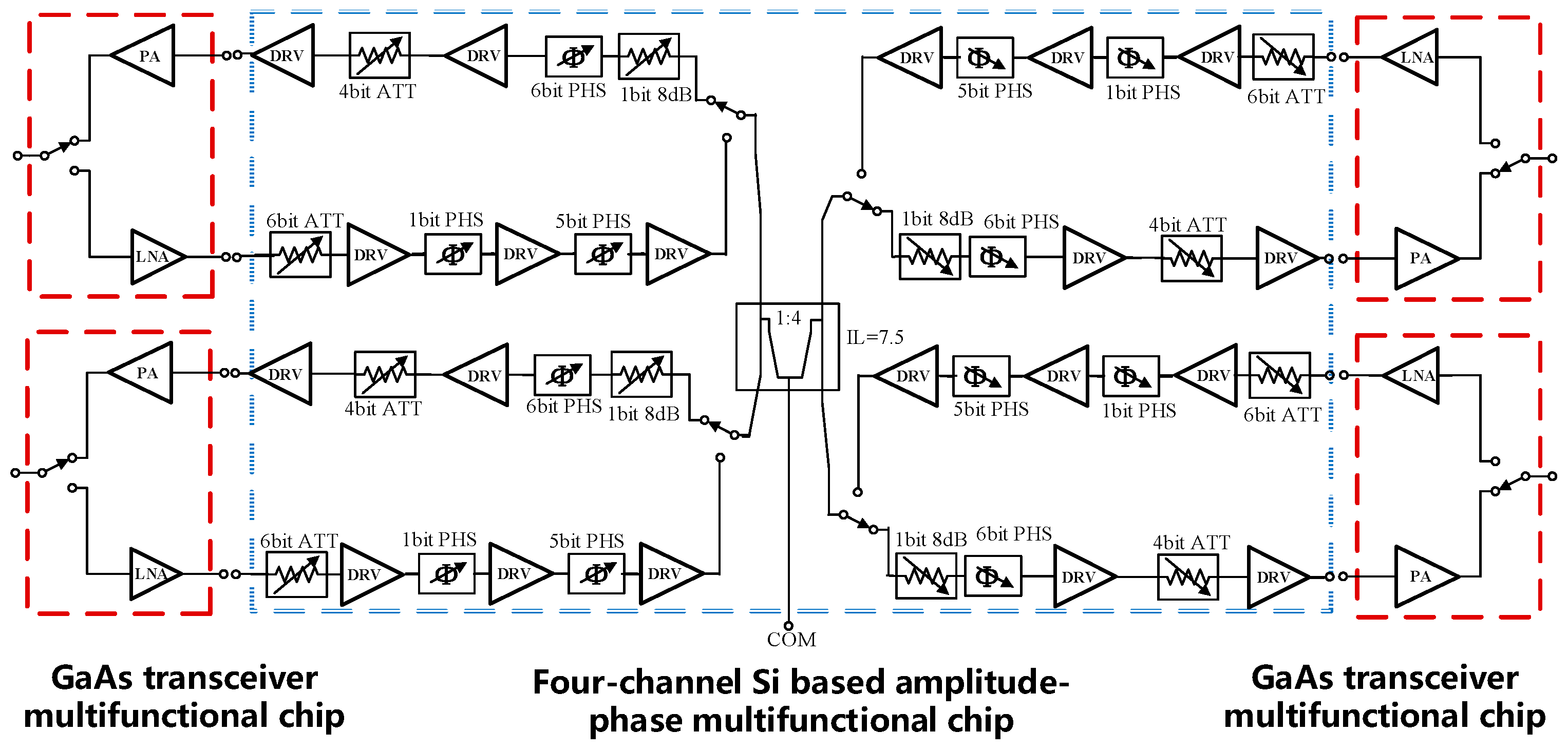
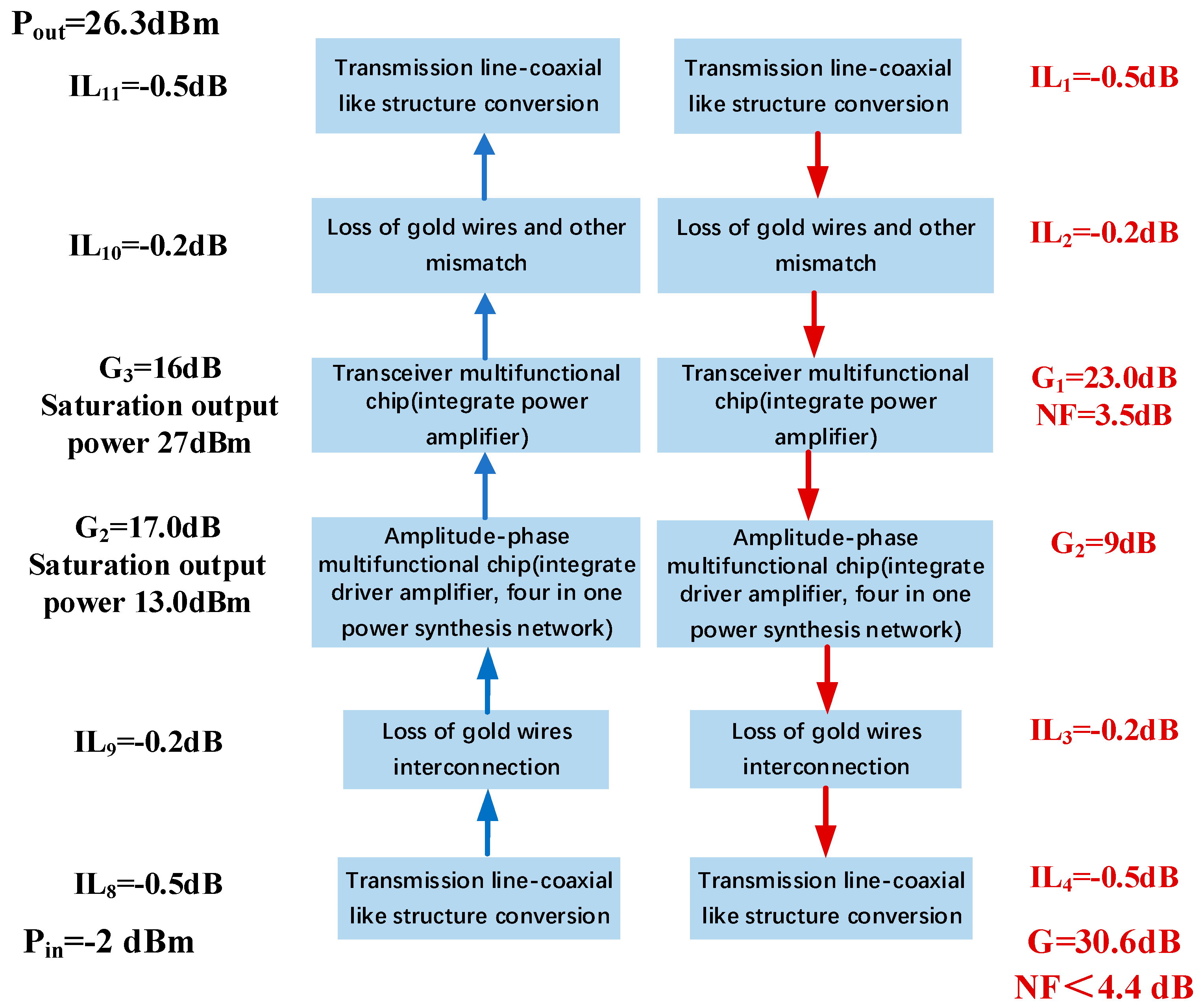
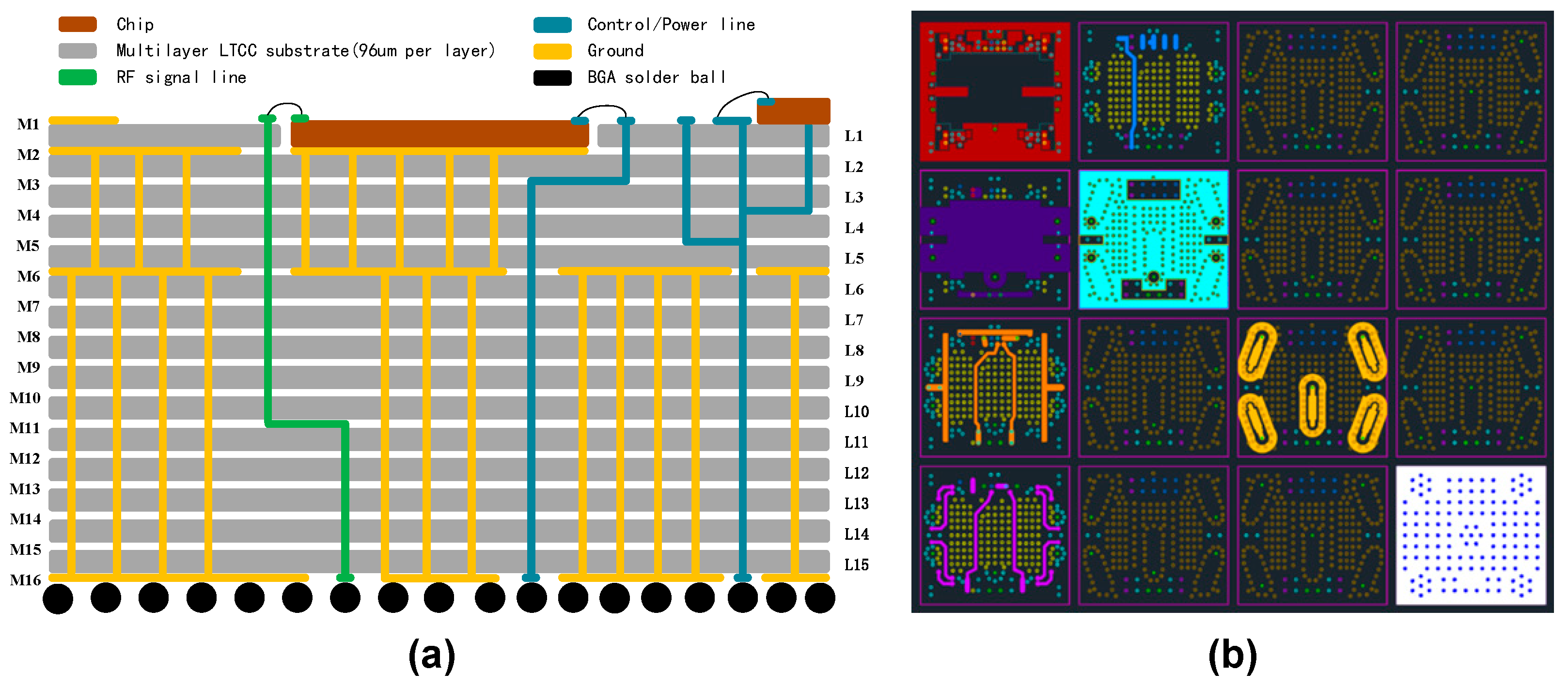
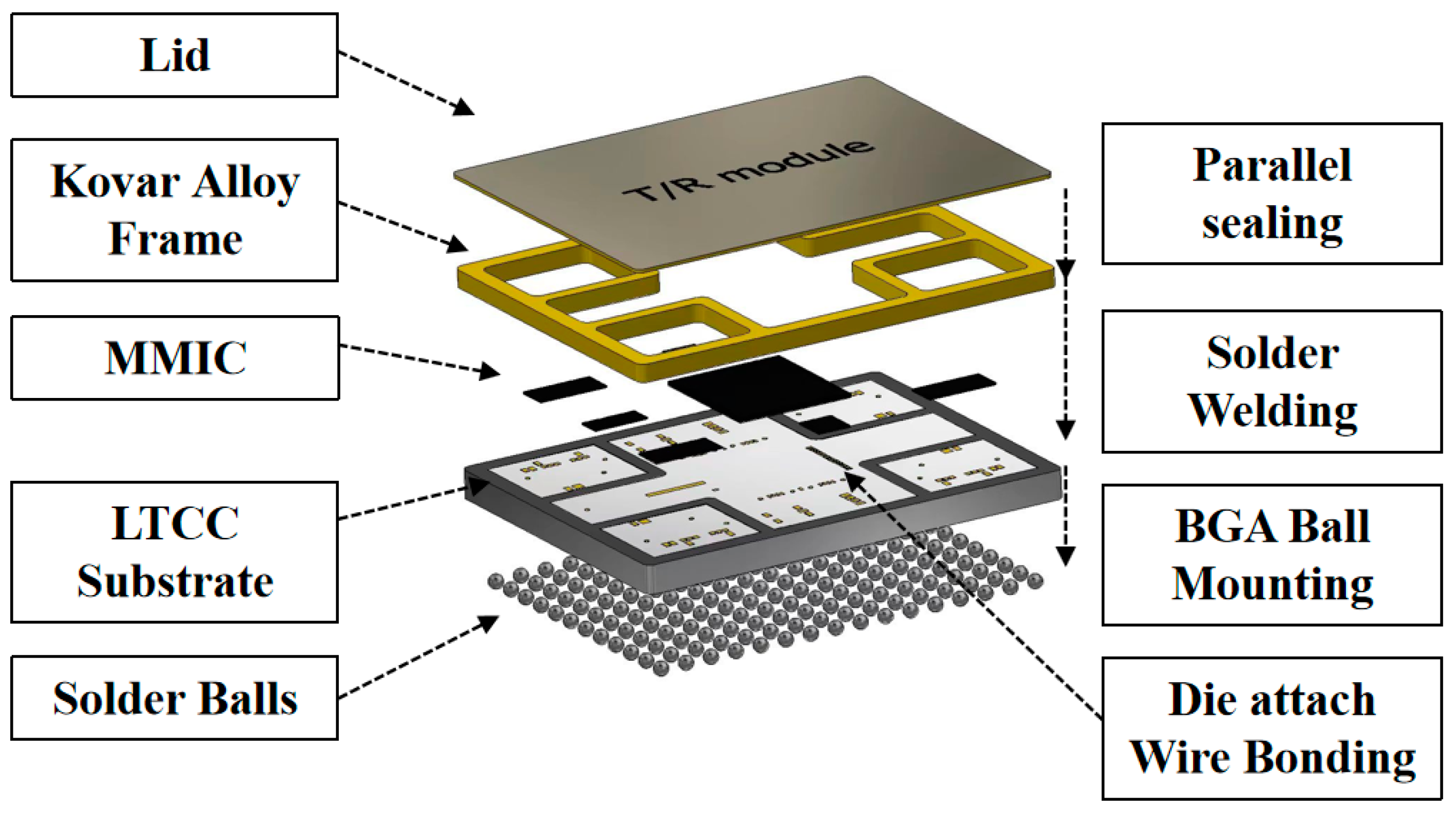
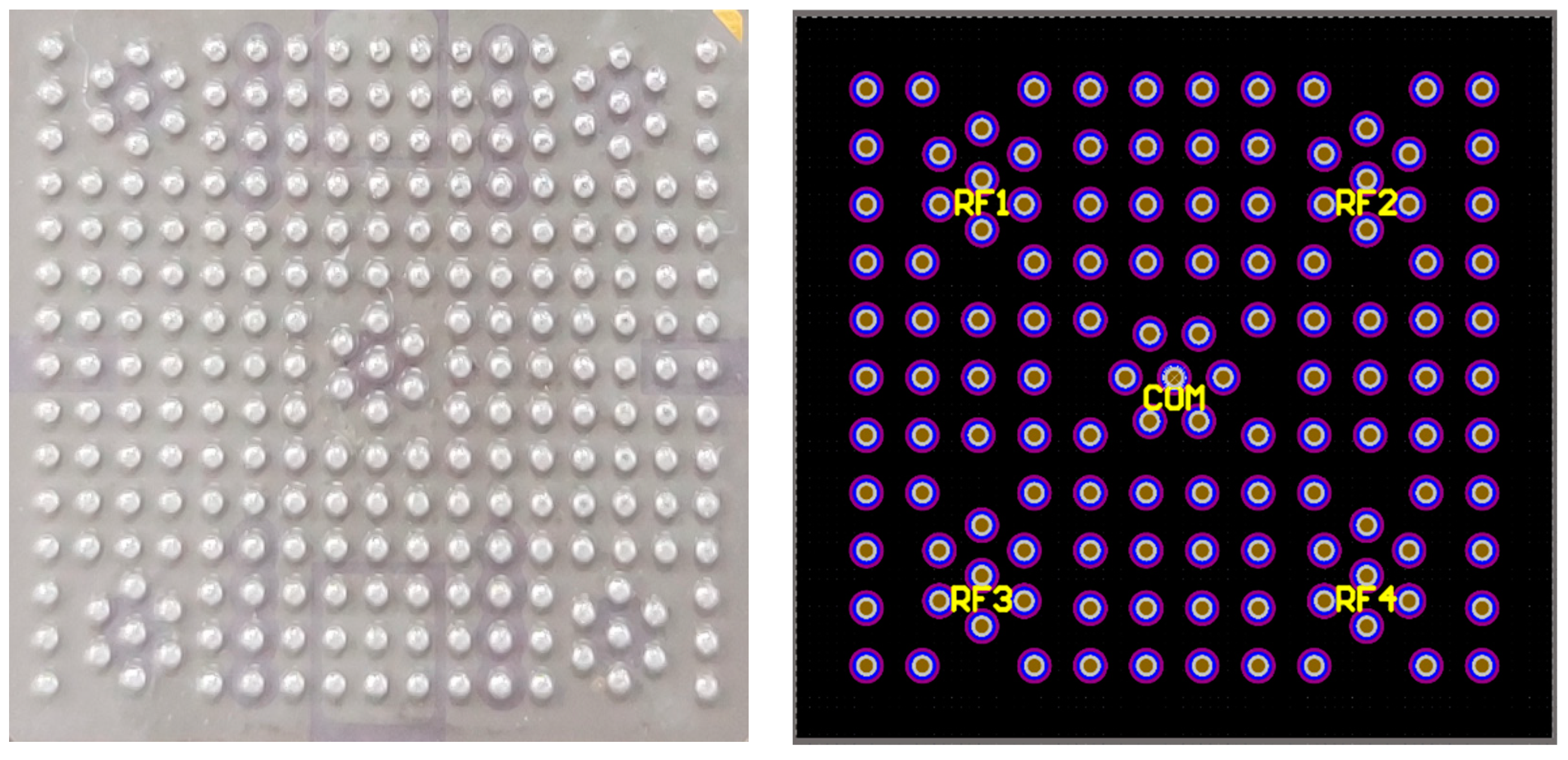

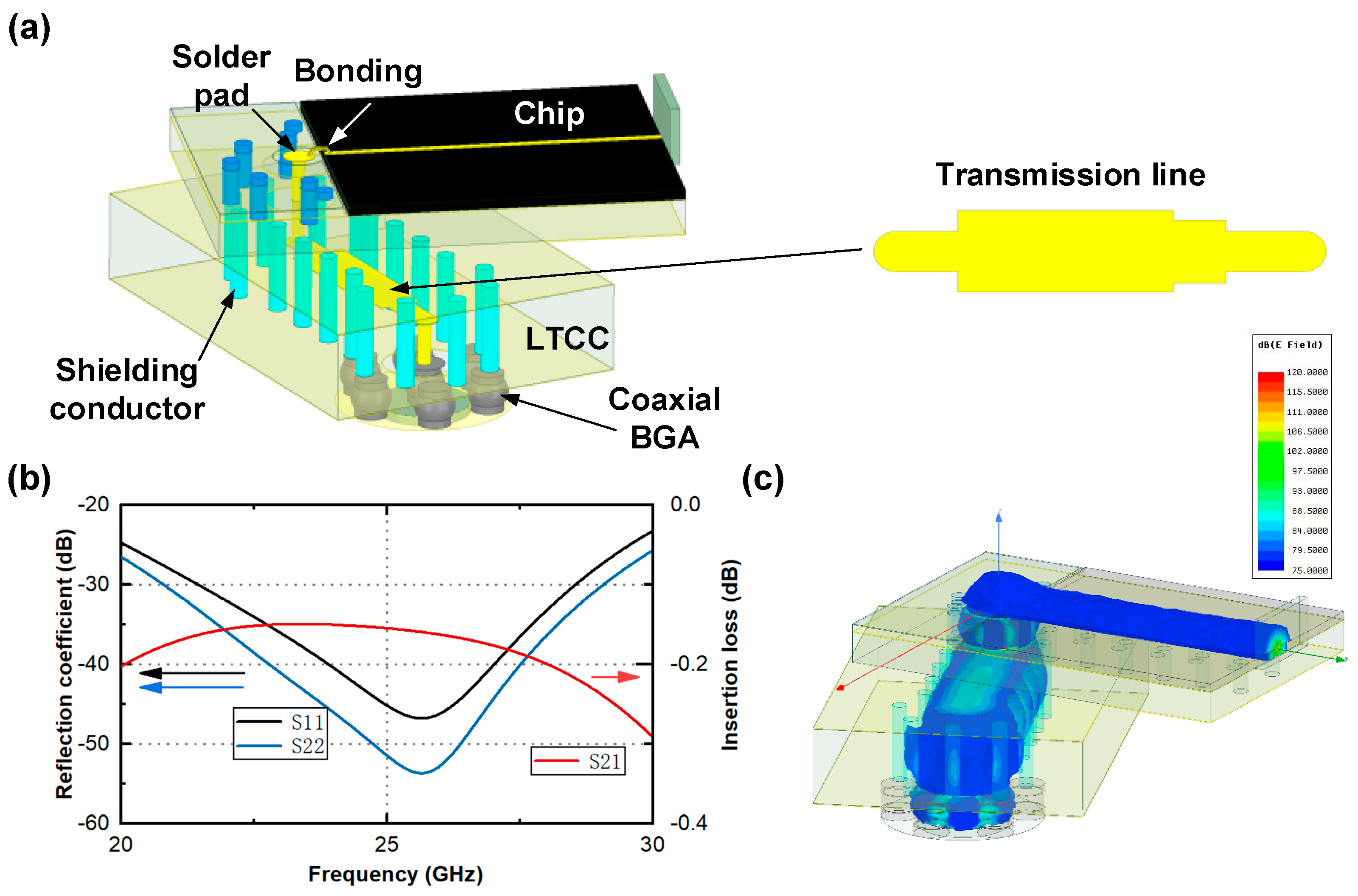
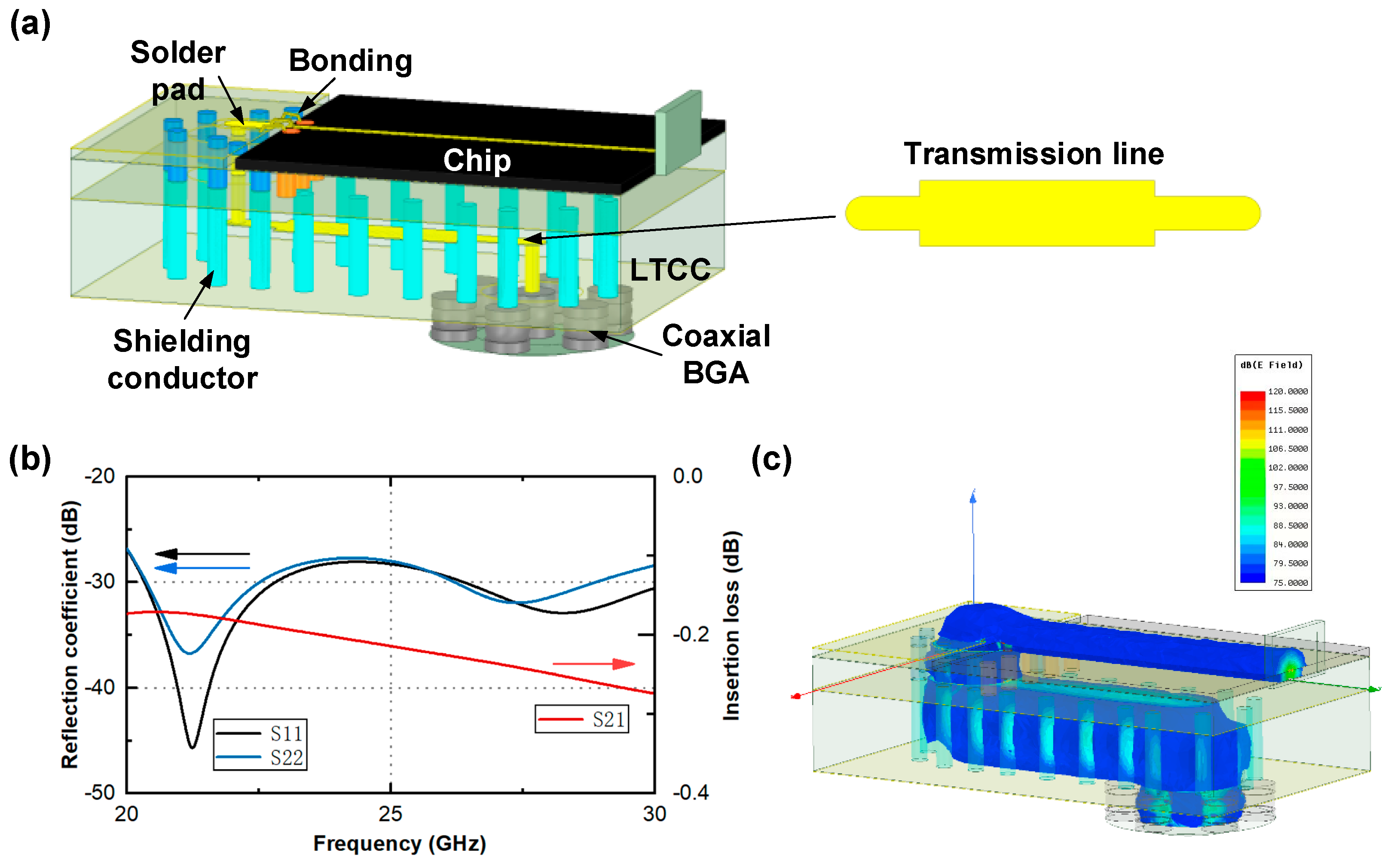
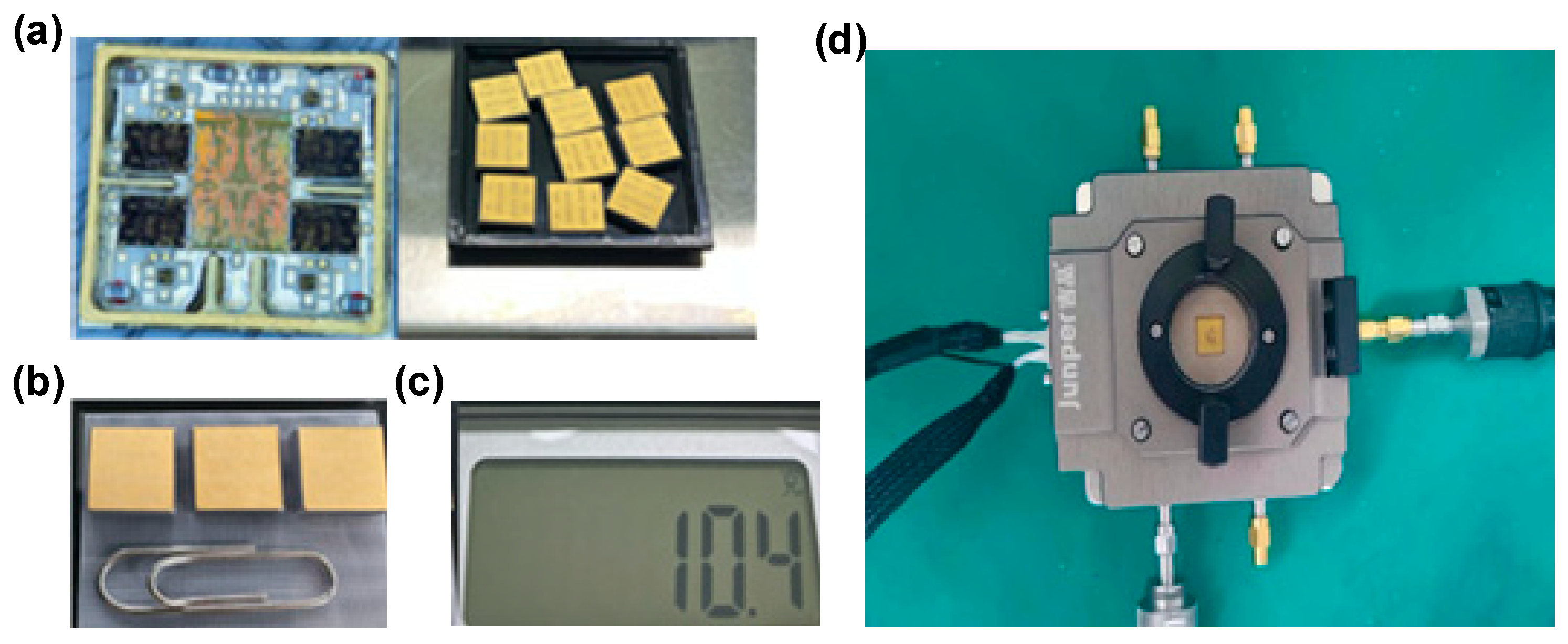


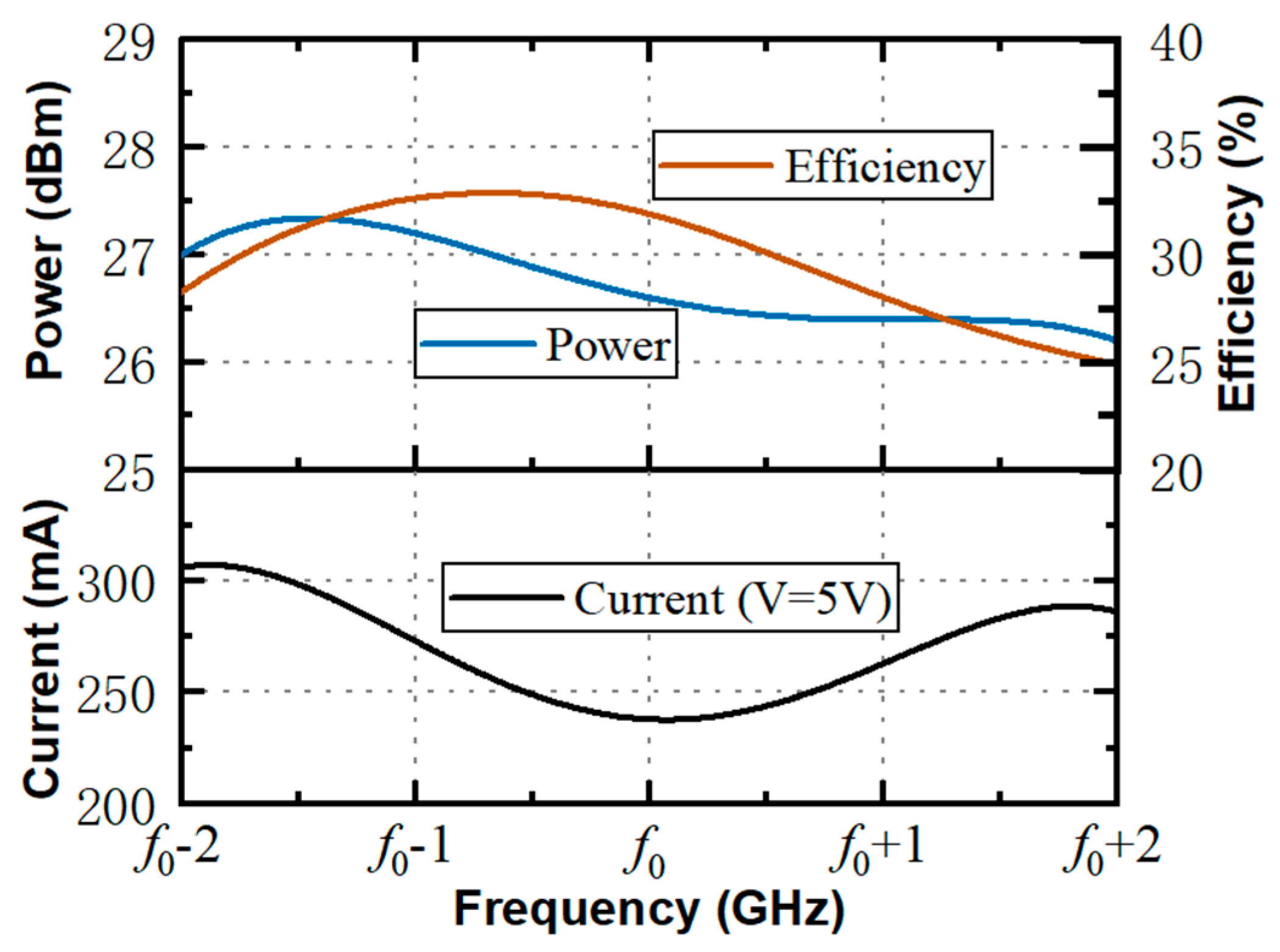
| Time | Institution | Module | Technique | Size | Output Power (dBm) | Noise Factor (dB) | Other Parameter | Reference |
|---|---|---|---|---|---|---|---|---|
| 2014 | University of Electronic Science and Technology of China | Ka-band 6-channel switching delay line module | LTCC | 84 mm × 47 mm × 15 mm | \ | \ | \ | [24] |
| 2015 | The 13th Research Institute, CETC | Ka-band 16-channel transmission module | PCB multilayer wiring technique and multi-chip assembly technique | 60 mm × 80 mm × 4.8 mm | >25 | \ | Linear gain > 25 dB | [25] |
| 2015 | Institute of Telecommunication Satellite, CAST | Ka-band T/R module | LTCC | 36 mm × 20 mm × l.l mm | >24.6 | <4.2 | Receiving gain ~33 dB, output gain > 25 dB | [26] |
| 2016 | Beijing Institute of Technology | Ka-band T/R array | LTCC | Single channel cross-section 6 mm × 25 mm | >10.5 | <4.5 | \ | [27] |
| 2016 | Xi’an Research Institute of Navigation Technology | Ku-band 3D miniaturized T/R module | LTCC, BGA | 9.5 mm × 9.5 mm × 3.8 mm | >24.5 | <3.5 | Receiving gain > 25 dB | [28] |
| 2016 | Ching-Yun Chu | Ka-band 4-channel T/R chip | 65 nm CMOS technique | 4 mm × 2.5 mm | ~18.5 | ~4.4 | \ | [29] |
| 2017 | Nanjing Research Institute of Electronics Technology | Ka-band 8-channel T/R module | LTCC | 43 mm × 39.5 mm × 3.5 mm | \ | \ | Return loss > 15 dB | [30] |
| 2020 | Southwest China Institute of Electronic Technology | Ka-band circularly polarized phased array antenna | LTCC | 46 mm × 44 mm × 2.8 mm | \ | \ | \ | [31] |
| 2020 | Nanjing Research Institute of Electronics Technology | Ka-band 64-channel phased array antenna | Silicon based packaging integration, chip embedded packaging | \ | \ | \ | \ | [32] |
| 2020 | Chengdu radio wave technology Co., Ltd. | Ka-band 128-unit tile phased array antenna | Integrated packaging of Si-based multifunctional and GaAs transceiver chips | 93 mm × 93 mm × 52 mm | >20 | <6.5 | \ | [33] |
| 2021 | Aerospace Information Research Institute, Chinese Academy of Sciences | Ka-band 4-channel T/R module | LTCC, BGA, multi-material heterogeneous integration | 10.8 mm × 10 mm × 3 mm | ≥26 | ≤4.4 | Efficiency ≥ 25% | This work |
| 2023 | The 13th Research Institute, CETC | Ka-band 4-channel T/R module | Silicon-based MEMs, TSV, 3D integration | 18 mm × 19.5 mm × 3 mm | ≥30 | ≤4.6 | [34] |
| Integrated Architecture of Phased Array Antenna Microsystems | Requirements for Chip Integration | Technique Requirements | Single Channel Output Power | Testability | Research and Development Cost | Million Level Batch Production Cost |
|---|---|---|---|---|---|---|
| Brick and wafer type | Low | Metal shells with multi-chip planar packaging; high- and low-frequency cable interconnection | High | Good | Low | High |
| Three-dimensional heterogeneous flat plate type | Relatively high | Ceramic, silicon, and glass adapter plates; embedded packaging; hybrid multilayer boards; and surface assembly | Relatively high | Relatively good | Relatively low | Relatively low |
| Silicon based RF circuit integration | High | SOC chips and their packaging techniques based on Si Complementary Metal Oxide Semiconductor (CMOS) and SiGe BiCMOS | Low | Relatively good | High | Low |
| heterogeneous integration | High | Si CMOS and SiGe BiCMOS wafer-based technique; direct heterojunction of silicon compounds | Low | Bad | Very high | Low |
| 2016 | Xi’an Research Institute of Navigation Technology | Ku-band 3D miniaturized T/R module | LTCC, Ball Grid Array (BGA) | 9.5 mm × 9.5 mm × 3.8 mm | Transmission output power > 24.5 dBm, receiver gain > 25 dB, and receiving noise factor < 3.5 dB | [17] |
Disclaimer/Publisher’s Note: The statements, opinions and data contained in all publications are solely those of the individual author(s) and contributor(s) and not of MDPI and/or the editor(s). MDPI and/or the editor(s) disclaim responsibility for any injury to people or property resulting from any ideas, methods, instructions or products referred to in the content. |
© 2024 by the authors. Licensee MDPI, Basel, Switzerland. This article is an open access article distributed under the terms and conditions of the Creative Commons Attribution (CC BY) license (https://creativecommons.org/licenses/by/4.0/).
Share and Cite
Zeng, Q.; Chen, Z.; He, M.; Wang, S.; Liu, X.; Xu, H. Design of a Ka-Band Heterogeneous Integrated T/R Module of Phased Array Antenna. Electronics 2024, 13, 204. https://doi.org/10.3390/electronics13010204
Zeng Q, Chen Z, He M, Wang S, Liu X, Xu H. Design of a Ka-Band Heterogeneous Integrated T/R Module of Phased Array Antenna. Electronics. 2024; 13(1):204. https://doi.org/10.3390/electronics13010204
Chicago/Turabian StyleZeng, Qinghua, Zhengtian Chen, Mengyun He, Song Wang, Xiao Liu, and Haitao Xu. 2024. "Design of a Ka-Band Heterogeneous Integrated T/R Module of Phased Array Antenna" Electronics 13, no. 1: 204. https://doi.org/10.3390/electronics13010204
APA StyleZeng, Q., Chen, Z., He, M., Wang, S., Liu, X., & Xu, H. (2024). Design of a Ka-Band Heterogeneous Integrated T/R Module of Phased Array Antenna. Electronics, 13(1), 204. https://doi.org/10.3390/electronics13010204









